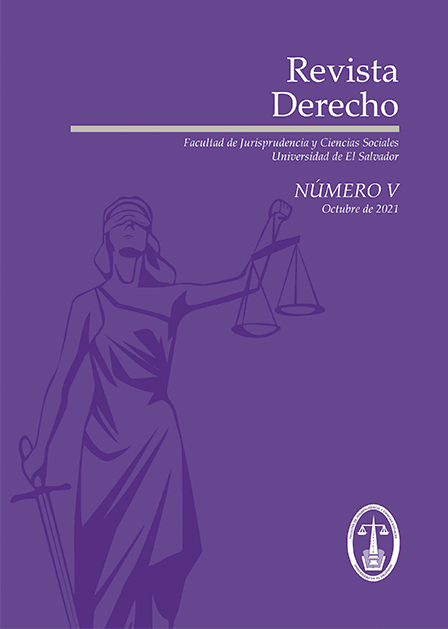Intellectual property, copyrights and the era of new technologies in El Salvador
Keywords:
Intellectual Property, Innovation and Development, Property Law, Moral Law, Software, Fourth Industrial Revolution, Registration, PatentAbstract
Intellectual property has been the object of protection by legal bodies throughout history since the appearance of the printing press, from the most basic manifestations of the expression of human ideas, to the great technological advances of the digital era in which we live today, these are the object of intellectual property protection, more specifically speaking of computer programs or software, which have had their greatest impact in the so-called fourth industrial revolution; this fourth industrial revolution is the one that, through the information technologies, promotes the business activity turning the intangible assets into goods of high economic value for the mercantile societies, but this right that empowers the intellectual property, has certain characteristics that must be met in order to be able to provide this protection. There is no single position as to the nature of copyright protection, forming eclectic positions as to it, but what all positions can be similar is their determination to protect the author’s inventive effort and its need for protection. In the commercial relations of the trader, intellectual property becomes a determining factor in its expansion and opening to new technological and globalizing markets, intellectual property becomes vital to maintain the competitive advantages in the irruption of these new digital markets.
Downloads
References
Mónica Bonnet, Innovación y Propiedad Intelectual: Tendencias Siglo XXI (Valencia: Tirant Lo Blanch, 2020), 13.
Miguel Ruiz Muñoz, Derecho de la propiedad intelectual, Derecho de autor y Propiedad Industrial (Valencia: Tirant lo Blanch, 2017), 34.
Ángel López y López, “Propiedad Intelectual y Perplejidades del Derecho Civil”, en Revista de Derecho Civil, vol. II, núm.2, abril‐junio, Sevilla, Universidad de Sevilla (2015): 171‐179.
German Darío Flores y Salazar Mayra Duran, Propiedad intelectual, nuevas tecnologías y derecho del consumo. Reflexiones desde el moderno derecho privado (Caracas: Universidad Católica de Colombia, 2017), 5.
Ana María Bonet de Viola, “La propiedad Intelectual como sistema asignativo moderno. Una genealogía Critica de las normas vigentes de acceso al conocimiento”, en Revista de la facultad de Derecho, N° 45, (Santa Fe: Universidad Católica de Santa Fe, 2018), 4.
El Acuerdo ADPIC (conocido como TRIPs por su abreviatura del inglés Agreement on Trade-Related Aspects of Intellectual Property Rights) fue firmado en el ámbito de la OMC en 1994, durante las negociaciones de la Ronda Uruguay, entró en vigencia en 1995 y es el principal instrumento internacional vigente en materia de PI. Contiene disposiciones en materia de patentes, derechos de autor, marcas, indicaciones geográficas y secretos comerciales, 15 de abril de 1994
Mónica Bonnet, Innovación y Propiedad Intelectual- tendencias Siglo XXI, (Valencia: Tirant Lo Blanch, 2020), 20.
José Carlos Erdozain, Manual de Propiedad Intelectual, 9ª Edición (Valencia: Tirant Lo Blanch 2019), 49.
Inmaculada Vivas Tesón, Cuestiones de actualidad en el ámbito de la propiedad intelectual (Valencia: Tirant Lo Blanch, 2015), 20.
María Serrano Fernández, El impacto de la Sociedad de la Información en la Propiedad Intelectual (Valencia: Tirant Lo Blanch, 2019), 25.
Jaime Alberto Díaz Limón, Antología Iberoamericana de propiedad intelectual (Valencia: Tirant Lo Blanch, 2018), 43.
Sala de lo Constitucional, 126-2017, (Corte Suprema de Justicia, El Salvador, 2017)
Ignacio Garrote Fernández Diez, Manual de Propiedad Intelectual, 6ª Edición (Valencia: Tirant Lo Blanch 2015), 36
Isabel Candelario Macías, Derecho de la Propiedad Intelectual, (Valencia: Tirant Lo Blanch, 2017), 58.
Gisela María Pérez Fuentes, Formatos Televisivos y Derechos de Autor (Valencia: Tirant Lo Blanch, 2015), 14.
Ley de propiedad intelectual de El Salvador, Decreto No 604 (El Salvador: Asamblea Legislativa, 1993), Artículo 5
Isabel Candelario Macías, Derecho de la Propiedad Intelectual, (Valencia: Tirant Lo Blanch, 2017), 61.
Teresita Chubretovic Arnaiz, La Protección de la Creación, Consejo Nacional de la cultura y las artes, (Santiago, 2014), 15.
Entendiendo el hardware, tal y como lo define la Real Academia de la Lengua Española, como “el conjunto de los componentes que integran la parte material de una computadora.
Wilson R. Ríos Ruiz, La Propiedad Intelectual en la Era de las Tecnologías, (Colombia: Universidad de los Andes, 2009), 259.
Isabel Candelaria Macías, Derecho de la Propiedad Intelectual (Valencia: Tirant Lo Blanch, 2017), 179.
El Acuerdo sobre los ADPIC (acuerdo de derechos de propiedad intelectual) y los instrumentos internacionales a los que hace referencia, (15 de abril de 1994).
Raquel Álamo Cerrillo, La Economía Digital y el Comercio Electrónico, (valencia: Tirant Lo Blanch, 2016), 12.
Organización de la Propiedad Intelectual, “Informe sobre propiedad Intelectual en el mundo”, en Series OMPI, “Economía y estadística”, 70
Antonio Millé, “Impacto del comercio electrónico”, en Revista Derecho de La Universidad Católica De Valparaíso, XIX, (Valparaiso,1998), 19.
José F. Alcántara, La Sociedad de Control, 1ª Edición (Barcelona, El Cobre Ediciones, 2008,) 235
Downloads
Published
How to Cite
Issue
Section
License
Copyright (c) 2021 Revista Derecho

This work is licensed under a Creative Commons Attribution-NonCommercial 4.0 International License.
The authors transfer the copyright rights in favor of the Faculty of Jurisprudence and Social Sciences of the University of El Salvador (through Aequus Editorial) to include their writing in Revista Derecho.








